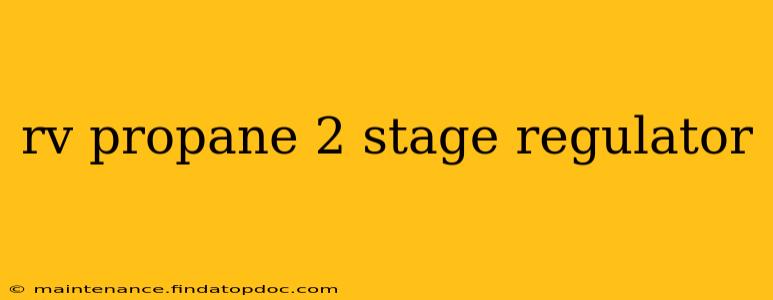Choosing the right propane regulator for your RV is crucial for safety and reliable appliance operation. A two-stage regulator offers superior performance and safety compared to single-stage models, making it a popular choice among RVers. This comprehensive guide will delve into the intricacies of RV propane two-stage regulators, addressing common questions and concerns.
What is a Two-Stage RV Propane Regulator?
A two-stage RV propane regulator is a pressure-reducing device that controls the flow of propane gas from your RV's tank to your appliances. Unlike single-stage regulators, which reduce the pressure in a single step, two-stage regulators perform this reduction in two phases. This staged approach offers several key advantages:
-
Improved Pressure Regulation: The first stage reduces the high tank pressure to an intermediate level. The second stage further reduces this pressure to the safe, low-pressure level required by your RV appliances. This ensures a consistent and stable propane supply, even with fluctuating tank pressure.
-
Enhanced Safety: The two-stage process minimizes the risk of over-pressurization, a significant safety concern with propane systems. The intermediate pressure stage acts as a buffer, preventing sudden pressure spikes that could damage appliances or create hazardous conditions.
-
Increased Appliance Lifespan: Consistent, regulated pressure prevents excessive strain on your RV's propane-powered appliances, contributing to a longer lifespan and reduced maintenance needs.
Why Choose a Two-Stage Regulator for Your RV?
The benefits of a two-stage regulator significantly outweigh those of a single-stage model, particularly for RVs. The consistent pressure regulation translates to more reliable appliance operation and enhanced safety, making it a worthwhile investment for peace of mind on the road. Many RVers find the added safety and performance justify the slightly higher initial cost.
How Does a Two-Stage Propane Regulator Work?
The process involves two distinct pressure reduction steps:
-
First Stage: The high-pressure propane gas from the tank enters the regulator and is reduced to a lower, intermediate pressure. This stage acts as a buffer, absorbing pressure fluctuations from the tank.
-
Second Stage: The intermediate-pressure gas then passes through a second pressure reduction stage, bringing it down to the low-pressure level required by the RV appliances (typically around 11 inches of water column). This ensures a steady and safe supply of propane.
What are the Common Sizes and Types of Two-Stage RV Propane Regulators?
RV propane regulators come in various sizes, typically rated by their input and output pressure capabilities. The most common size is designed to handle the standard 20-pound RV propane tank. While there aren't distinct "types" beyond single- and two-stage, you'll find variations in features such as built-in gauges, different mounting styles, and material construction (brass is common).
How Often Should I Replace My RV Propane Regulator?
While there isn't a universally prescribed replacement interval, it's generally recommended to inspect your regulator annually and replace it every 5-10 years, or sooner if you notice any signs of damage, leaks, or malfunction. Regular inspections are critical for safety and reliable operation.
What are the Signs of a Failing RV Propane Regulator?
Several indicators suggest your regulator needs attention or replacement:
- Weak or inconsistent appliance performance: If your propane appliances are struggling to operate or produce inconsistent flames, a malfunctioning regulator might be the culprit.
- Unusual noises: Hissing or whistling sounds from the regulator indicate a potential leak or internal problem.
- Visible damage: Cracks, dents, or other signs of physical damage to the regulator require immediate replacement.
- Low propane pressure despite a full tank: If your appliances are not functioning despite a full propane tank, this could point towards regulator failure.
How Do I Choose the Right Two-Stage RV Propane Regulator?
Selecting the correct regulator depends on the size of your propane tank and the demands of your RV's propane-powered appliances. Consult your RV's owner's manual for specific recommendations regarding the appropriate input and output pressure ratings. Always choose a regulator that meets or exceeds these specifications. Consider features such as built-in gauges for easy pressure monitoring.
This comprehensive guide should equip you with the knowledge to confidently choose and maintain a two-stage RV propane regulator, ensuring safe and reliable operation of your propane appliances while on the road. Remember, regular inspection and timely replacement are crucial for maintaining safety and extending the lifespan of your system.
